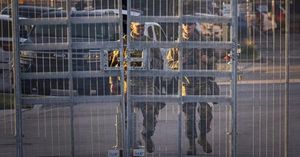Londoners braced themselves for another week of travel headaches as a major strike by Rail, Maritime and Transport (RMT) union members all but shut down the London Underground, forcing commuters to seek alternative routes and plunging the city’s transport network into chaos. The industrial action, which began on Sunday, September 7, 2025, reached its full disruptive potential on Monday, September 8, when nearly all Tube services were suspended, leaving millions scrambling for buses, bikes, and any other means to get to work, school, or appointments.
The strike, which saw participation from drivers, signallers, and maintenance workers, is rooted in a protracted dispute over pay and working conditions. At the heart of the conflict is the RMT’s demand for a 32-hour working week—a reduction from the current 35 hours—as well as a 3.4% pay rise and, as has recently emerged, a 75% discount on all personal rail travel for staff, including leisure trips on mainline trains outside London. According to The Telegraph, all Transport for London (TfL) employees and a family member or partner already enjoy free travel across the capital’s network, and those living outside London receive a 75% reimbursement on National Rail commuting costs. The new demand would extend these benefits even further, something TfL has called unworkable.
Negotiations between the union and TfL had dragged on for nine months before the strike vote, but failed to yield a resolution. TfL has offered a 3.4% pay increase, which it described as “fair,” but insists that the union’s push for a shorter working week would cost hundreds of millions of pounds—a figure RMT organiser Jared Wood disputes. “They’re throwing in everything they can imagine to come up with a figure of hundreds of millions – it would not be near hundreds of millions to make real progress,” Wood told the BBC. He added, “At the end of this week we hope to be in meaningful discussions where the company comes up with a way of resolving this.”
For Londoners, the impact was immediate and severe. On Monday, buses were packed to the brim and traffic ground to a standstill in parts of the city. TfL reported a 12% increase in bus card usage by 1:00 PM compared to the same Monday last year, and the demand for London Overground and Elizabeth line services soared by 31%. According to The Guardian, the Elizabeth line saw a 31% jump in journeys, while the London Overground was up 23%. Even so, overall public transport usage was down by about a fifth, with many simply opting to stay home.
For those determined to travel, two wheels proved to be the way forward. E-bike providers Lime and Forest reported significant surges in usage—Lime had 58% more users on Monday morning, while Forest doubled its rush-hour numbers. TfL’s own cycle hire scheme saw more than 20,000 hires by 3 PM, double the previous Monday’s rate. The scramble for alternatives was so intense that TfL’s website and journey planner app crashed under the weight of searches, leaving many Londoners in the lurch as they tried to plan their commutes.
Private transport wasn’t much easier. Roads became choked with congestion, causing lengthy delays for buses, cars, and taxis. The ride-hailing app Uber warned users to expect higher fares due to increased demand, with some five-mile trips costing around £50—a hefty price for a city already grappling with a high cost of living.
The disruption is expected to continue all week, with few or no Tube services running from Monday through Thursday. Separate industrial action by RMT members on the Docklands Light Railway (DLR) has also led to full suspension of DLR services on Tuesday and Thursday. According to BBC News, the last Tube-wide strike was three years ago, but this week’s action is more complex, as separate groups of workers are walking out on different days, making it difficult for TfL to predict day-to-day service levels.
The political response has been swift and pointed. Downing Street called on both sides to return to the negotiating table, with the Prime Minister’s spokesperson telling the Press Association, “I think Londoners will rightly be fed-up with the disruption from Tube strikes… as parents try and drop their kids off at school, get to hospital appointments, get to work. We want to see RMT and TfL get back around the table when it comes to these strikes, work together in good faith to resolve this situation in the interests of passengers.” London Mayor Sir Sadiq Khan echoed this sentiment, describing the industrial action as “bad news for London.” He added, “TfL have made clear they can’t afford its workers working fewer hours for more pay, but they are willing to talk to the RMT and other unions whenever there is a dispute and to try and resolve things amicably.”
TfL’s Chief Operating Officer, Claire Mann, expressed disappointment at the union’s decision to proceed with the strike despite the pay offer. “We are bitterly disappointed that the RMT has chosen to go ahead with this action despite our fair, affordable pay offer. We have been clear that their demand for a reduction in the working week is unaffordable and impractical, and we urge them to put our offer to their members.” She also acknowledged the economic toll, particularly on businesses in the hospitality and leisure sectors, and pledged to keep as much of the network running as possible.
The RMT, for its part, insists that the strike is not intended to hurt the public or small businesses. “We are not going on strike to disrupt small businesses or the public. This strike is going ahead because of the intransigent approach of TfL management and their refusal to even consider a small reduction in the working week in order to help reduce fatigue and the ill-health effects of long-term shift work on our members,” an RMT spokesperson told The Guardian. The union also points to TfL’s reported surplus of £166 million last year and its £10 billion annual operating budget as evidence that their demands are reasonable and affordable.
Support for the union’s push for a shorter working week has come from the 4 Day Week Foundation. Joe Ryle, the foundation’s campaign director, said, “We offer our full support to the RMT leading the fight for a 32-hour working week. Every union that takes action to secure a shorter working week brings the four-day week closer to reality for everyone. It’s a bold and necessary stand, and these workers deserve widespread support. The five-day week is a century-old model that no longer reflects how we live and work today. We are long overdue an update.”
As the week unfolds, signallers and controllers are set to strike on Tuesday, further complicating efforts to keep the city moving. TfL has urged the RMT to put its pay offer to a fresh ballot, while the union maintains it has a mandate for further industrial action if no progress is made. RMT regional officer Jared Wood told the PA news agency that while the union does not want to call more strikes after this week’s walkouts, it is prepared to do so if necessary. “Our members are not asking for a lot, but we want to see real progress towards a shorter working week,” he said.
With underground services not expected to resume until at least 8 AM on Friday, Londoners face several more days of gridlock, crowded buses, and surging bike hires. Whether the RMT and TfL can break the deadlock remains to be seen, but for now, the capital’s commuters are left to navigate a city brought to a virtual standstill by one of the most significant transport strikes in recent years.






